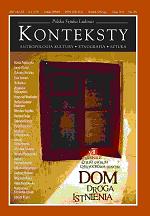„Dom martwych zwierząt”
„The House of Dead Animals”
Author(s): Małgorzata Kitowska-ŁysiakSubject(s): Anthropology
Published by: Instytut Sztuki Polskiej Akademii Nauk
Keywords: anthropology; home; animals
Summary/Abstract: The titular description „The Home of Dead Animals” denotes ataxidermy laboratory in which dead animals are granted an ‘illusion of life'. The article is illustrated by literary and artistic examples of the mentioned motif. Artists made frequent use of dead animals, including stuffed ones, starting with the Dutch still life, espe- cially of the vanitas variety. Ataxidermist who conse- rves and renders immortal resembles a vanitas painter. The iconography of taxidermy, however, is not exten- sive (see, e. g. Henry Coeylas’ /1880-1920/ Reconstruc- tion of the Dodo Bird in the Laboratory of Prof. Qustalet /1903/, apainting of value for the natural sciences). Artists much more frequently resorted to the motif of an abattoir and depicted skinned animals (Rem- brandt, Goya, Soutine, Bacon et al.). While admiring their masterful qualities, the critics, as arule, omitted the eschatic dimension of such works. Aslightly diffe- rent aspect of the problem is disclosed by the assem- blages by Robert Rauschenberg: Odalisque and Mono- gram (1955-1959) and the performances byBeuys: Si- berian Symphony (3 February 1963) and How to Expla- in Pictures to aDead Hare (1965). Compositions by Rauschenberg are autonomous objets d’art that igno- re ultimate issues, in contrast to Beuys, whose oeuvre spans between life and the trauma of the threat and death. Alongside the 'Rauschenberg model' (a dead animal envisaged as apassive element of the world of art) and the 'Beuys model' (a dead animal as aphysi- cal 'participant' of the artist’s activity) there is Animal Pyramid (1993) by Katarzyna Kozyro, showing the da- ily proximity of death; by breaking ataboo Kozyro at- tained that which contemporary art finds particularly difficult – the sphere of the ultimate.
Journal: Konteksty
- Issue Year: 2010
- Issue No: 02-03
- Page Range: 267-275
- Page Count: 9
- Language: Polish
- Content File-PDF

